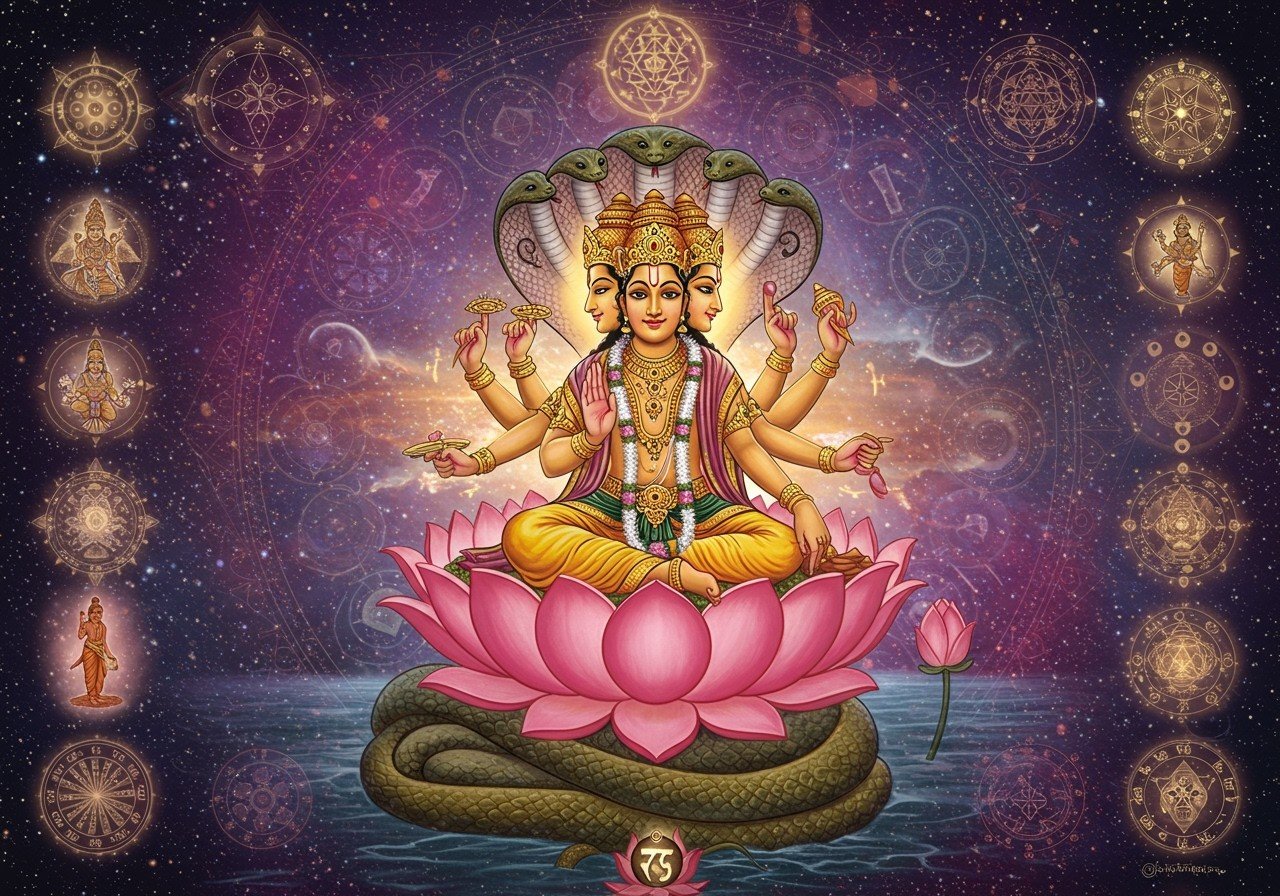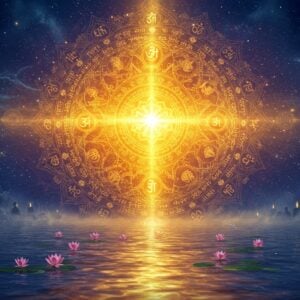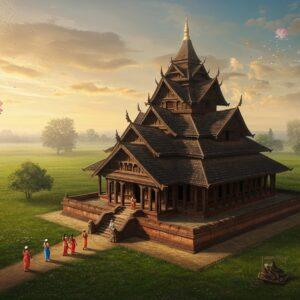
Hindu cosmology is a vast and profound system that offers a unique understanding of the universe. It combines philosophical and spiritual ideas to explain the creation, maintenance, and eventual dissolution of everything around us. Ancient texts like the Vedas and Puranas play a key role in preserving these deep concepts, while deities symbolize important cosmic principles. The cyclical nature of time and key terms like ‘Brahmanda‘ (cosmic egg) and ‘Pralaya‘ (dissolution) provide a deeper insight into this fascinating worldview. At poojn.in, we offer a wide selection of products related to Hindu deities and rituals. Shop now to explore our collection.
Understanding the Core of Hindu Cosmology
Hindu cosmology views the universe as a dynamic and ever-changing entity. It describes the universe as starting with ‘Srishti‘, or creation, initiated by Brahma, the creator. The universe is made up of different ‘Lokas‘, or realms, such as Bhuloka (earthly realm) and Swargaloka (heavenly realm). These realms are interconnected and influenced by the five elements—earth, water, fire, air, and ether—known as ‘Panchabhuta‘.
The universe and its beings are also shaped by three fundamental qualities called ‘Gunas‘: sattva (purity, balance, and harmony), rajas (passion, activity and dynamism), and tamas (ignorance, darkness and inertia). These qualities affect behavior and interactions within the cosmos. Furthermore, every soul is encased in layers called ‘Kosha‘, which influence its journey through life. The concept of ‘Maya‘ adds another layer, representing the illusion that veils the true nature of reality. This intricate system reflects a balance of cosmic principles that guide individuals in their spiritual journey. You can find a wide range of books and resources on Hindu philosophy at poojn.in.
Delving into the Wonders of Hindu Cosmology
Cyclical Time
In Hindu cosmology, time isn’t linear; it’s cyclical. Everything moves in cycles of creation, preservation, and transformation. Imagine a giant clock where the universe is born, lives, and then transforms, only to begin anew. This is the cycle of Kalpas. Each Kalpa is a day in the life of Brahma, lasting about 4.32 billion years. When a Kalpa ends, the universe transforms through elements like fire or water. Brahma creates, Vishnu preserves, and Shiva transforms—a cosmic dance that never ends. For a deeper understanding of these cycles, explore our collection of sacred texts at poojn.in.
The Yugas
Within each Kalpa are smaller cycles called Yugas. They represent different ages with varying levels of spiritual consciousness and dharma. The first, Satya Yuga, is an age of truth and purity. Then comes Treta Yuga, followed by Dvapara Yuga, and finally Kali Yuga—a time of challenge and change. Each Yuga holds unique lessons and influences our understanding of dharma (duty or righteous conduct) and karma (action and consequence) and their interplay in the cycle of Samsara (rebirth). Learn more about Dharma and Karma by visiting poojn.in.
The Essence of Brahman
Brahman is the fundamental principle of Hindu cosmology. It is the ultimate reality, the source of all existence, omnipresent and unchanging. It is the formless, infinite, and eternal foundation of all that exists. Brahman manifests as Brahma, Vishnu, and Shiva, demonstrating the ever-changing nature of the universe. Discover more about Hindu Gods and Goddesses at poojn.in.
Worlds Within Worlds
Hindu cosmology describes a universe with multiple layers, or ‘Lokas‘. There are three main levels: heaven (Swarga), earth (Bhuloka), and the netherworld (Patala). Each layer further divides into sub-levels, creating a complex cosmic hierarchy. Earth comprises seven continents, with Bharatavarsa (India) holding a significant place. Learn more about Hindu symbols and their meanings at poojn.in.
Mount Meru
Mount Meru stands at the center of the universe as the cosmic axis. The stars and sun revolve around it, with Dhruva (the North Star) as their reference point. This sacred mountain connects heaven and earth, signifying stability and order amidst change. Poojn.in offers a range of products related to Hindu deities and rituals. Shop now to explore our collection.
The Cosmic Fabric
The Vedas depict the universe as a vast interconnected web, where each element and being represents a thread in this intricate design. This interconnectedness emphasizes that all actions have consequences that reverberate throughout the cosmos. This interconnectedness highlights the importance of dharma (duty) and karma (action and consequence), emphasizing our role in maintaining cosmic balance. For a deeper understanding of Hinduism’s core beliefs and practices, visit poojn.in.
How Poojn.in Can Enhance Your Connection to Hindu Cosmology
Poojn.in provides a wide variety of products and resources to deepen your understanding and practice of Hindu cosmological concepts:
- Sacred Texts and Books: We offer a comprehensive collection of Vedas, Puranas, and other scriptures that delve into cosmic creation and philosophical concepts. Explore books on Hindu astronomy, time cycles, and the various Lokas (realms). Our illustrated guides can help you visualize and understand these complex concepts.
- Ritual Items for Cosmic Worship: Enhance your spiritual practice with special lamps and diyas designed for planetary prayers. We offer Yantra (sacred geometry) items to promote cosmic alignment, along with incense and dhoop for celestial offerings. These authentic items can enrich your connection to the divine and cosmic energies.
- Deity-Specific Products: Deepen your devotion with idols of Brahma, Vishnu, and Shiva, representing the cosmic trinity. We also offer items for Navagraha (nine planets) worship and Surya (Sun God) worship, enabling you to connect with specific cosmic forces. Our collection helps you personalize your spiritual practice and focus on specific deities or planetary influences.
- Educational Resources: Poojn.in provides digital content explaining Hindu cosmic concepts, offering a convenient way to learn and explore this rich tradition. Our guides explain how to perform rituals aligned with cosmic events and provide information on the astrological significance within Hindu practices. Expand your knowledge with our educational resources, available at your fingertips.
Visit Poojn.in to discover our complete collection of authentic items for cosmic worship and a deeper understanding of Hindu cosmology. All products are verified for authenticity and come with detailed usage instructions. We offer pan-India delivery and expert guidance for product selection.
Shop Now for Cosmic Worship Items
Embracing the Cosmic Wisdom within Hindu Cosmology
Hindu cosmology encourages us to perceive the universe as a dynamic, interconnected entity filled with wisdom and wonder. It reveals that life is not merely a sequence of random occurrences but rather an integral part of a vast cosmic cycle. By understanding these cycles—Kalpas, Yugas, and the essence of Brahman—we gain profound insights into our place within the universe. This tradition prompts reflection on our actions, underscoring the delicate interplay between dharma and karma. As we journey through the cycles of time, we learn to appreciate the interconnectedness of all things. Mount Meru, the concept of multiple worlds, and the cosmic fabric serve as constant reminders of our shared journey.
By embracing these timeless concepts, we find guidance and solace in our daily lives. Hindu cosmology, with its profound reverence for life and the universe, provides not just knowledge but a pathway to live in harmony with the world around us. For those seeking a deeper understanding of Hanuman’s journey and its significance within Hindu cosmology, visit poojn.in.
FAQs on Hindu Cosmology Theories and Concepts
What is Hindu cosmology? Hindu cosmology is the ancient Indian framework for understanding the universe – its origins, structure, cycles, and the interplay of its elements. It incorporates multifaceted theories about time, dimensions, and the cyclical nature of creation and destruction. It provides a holistic view that intertwines the physical and metaphysical realms.
How does Hindu cosmology explain the creation of the universe? Hindu cosmology posits a cyclical model of creation and destruction, with the universe originating from a cosmic egg or “Brahmanda”. Lord Brahma, the creator god, oversees this process, bringing forth the universe from a state of potentiality to manifestation. Each cycle concludes with a period of dissolution (Pralaya), before the process begins anew.
What are Yugas in Hindu cosmology? Yugas represent the four ages within a Kalpa (a cycle of creation and destruction): Satya Yuga, Treta Yuga, Dvapara Yuga, and Kali Yuga. Each Yuga embodies specific characteristics and durations, signifying different stages of spiritual consciousness and moral decline. They offer a framework for understanding the cyclical nature of time and its influence on human society and spiritual development.
How is time measured in Hindu cosmology? Hindu cosmology utilizes vast cyclical timeframes. A “Kalpa”, representing one day of Brahma, equates to approximately 4.32 billion human years. Each Kalpa comprises 14 Manvantaras, with each Manvantara encompassing 71 cycles of the four Yugas. These vast cycles highlight the cyclical nature of existence and the immense scale of cosmic time.
What is the significance of the cosmic ocean in Hindu cosmology? The cosmic ocean, known as “Kshira Sagara,” symbolizes the infinite, primordial source of creation. It’s where Vishnu rests and plays a central role in the Samudra Manthan (churning of the ocean), a mythical event that brought forth divine treasures. The cosmic ocean signifies the potent and transformative power that underlies the manifested universe.
How do Hindu cosmology theories explain the universe’s structure? Hindu cosmology describes a multi-layered universe comprising various “lokas” or realms of existence. These include the physical world (Bhuloka), heavenly realms (Swarga), and netherworlds (Patala). Each loka is governed by specific deities and subject to unique laws of nature and existence. This complex structure reflects a hierarchical organization of cosmic reality.
Why is the concept of Maya important in Hindu cosmology? “Maya” refers to the illusory nature of the perceived reality, veiling the ultimate truth of Brahman. It represents the power that makes the temporary and ever-changing world appear real and substantial. Understanding Maya is crucial to spiritual progress, as it encourages one to look beyond the illusions and seek the underlying reality.
What role do gods play in Hindu cosmology? Gods in Hindu cosmology represent cosmic forces and principles responsible for maintaining cosmic order and the cyclical processes of creation, preservation, and destruction. Brahma, Vishnu, and Shiva embody these fundamental forces. Other deities play specific roles within the cosmic hierarchy, upholding dharma and guiding the universe’s evolution.


